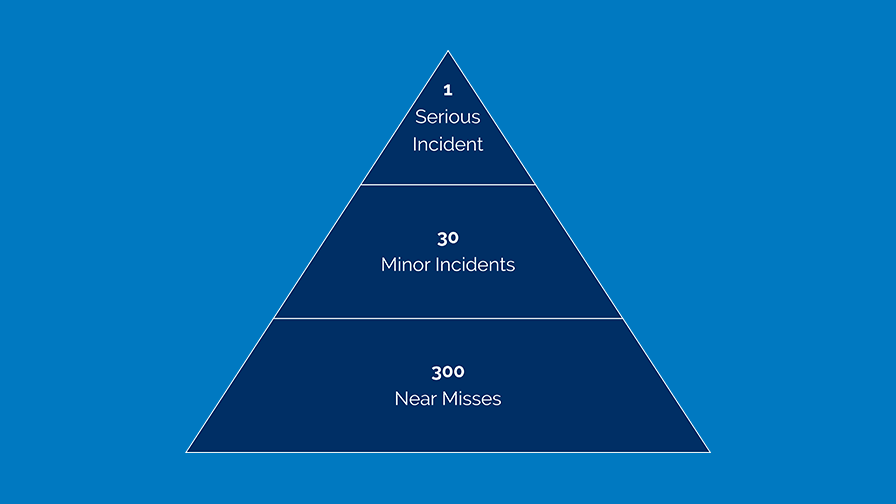- Vegetation Management Services
- Industries
- In Your Neighborhood
- About
- Careers
- Webinars
- Articles
Treating Complacency Like a Disease

Treating Complacency Like a Disease
By Adrienne Jones, safety manager, ACRT
The concept of a disease can be described as a condition that impairs normal functioning or harmful development. Do you notice any parallels with complacency?
To spot the signs of complacency, the National Safety Council notes that first, you must be able to identify the following signs in yourself.
- Dissatisfaction with your work and/or lack of motivation
- Missing steps in work processes
- Frequent near-misses or incidents
Take a look at Heinrich’s Pyramid. In his book Industrial Accident Prevention: A Scientific Approach, he explains for every 300 near misses or first aid incidents, there are 30 minor incidents or injuries, and of those 30, one is a serious incident or fatality.
According to the U.S. Bureau of Labor Statistics, in 2021, there were 2,607,900 nonfatal injuries and illnesses reported and of those incidents, 5,190 were fatal incidents — up 8.9% from 2020.
There’s a powerful poem “I Chose to Look the Other Way” by Don Merrell that speaks volumes about complacency. The opening line reads, “I choose to look the other way. I could have saved a life that day. But I chose to look the other way.” The poem explores not wanting to inconvenience someone or take the time to pause, what it means for the person who didn’t speak up and the consequences of their actions — or lack thereof. It’s important to think about our choices, maintain a questioning attitude, and what’s going to happen as a result of them.
Combatting complacency
An article by Jeremy McCombs, an ACRT Arborist Training instructor, reminds readers that complacency comes well-equipped with consequences including lost work time, lost mobility or health, lost family time, lost production, permanent disability, or death.
So how can we work towards combatting complacency? Stop Work Authority (SWA) is an excellent tool to implement throughout your organization (if there’s not a policy already in place).
Thanks to the Occupational Safety and Health Administration (OSHA), workers have a right to refuse dangerous work. This standard, along with SWA, grants you, as a worker at any seniority, the authority to halt operations any time something is unclear, conditions are unsafe, things don’t seem right, there is confusion, conditions change, there’s an emergency, and so on.
When it comes to complacency, I like to ask myself and others: “If you were faced with a hazard, would you want someone else to raise a red flag?” While we are all accountable for our own safety, we also have a moral obligation to keep each other safe.
It can be intimidating to speak up, especially if you’re new to an organization or are surrounded by industry veterans. Organizations can help alleviate apprehension by implementing reporting methods such as near-miss reporting, anonymous red flag reporting, and introducing peer safety representatives.
It’s important to establish peer-to-peer relationships for this very reason. People are more likely to open up to a peer, such as a fellow field employee who knows the situation and the people involved.
The message I try to send to people is if you didn’t say something, how will that feel if something happens? There are a lot of powerful messages surrounding the “What if?” I encourage people to think about what’s more important: inconveniencing people for a couple of minutes by stopping work or encountering an incident. How costly will that be for someone’s life and the work you’re doing?
A questioning attitude can be an anecdote to complacency. Don’t ignore the signs of complacency in yourself and don’t be afraid to voice concerns when you see them in others. I encourage everyone in our industry to establish a relationship of trust, respect, and accountability with at least one person they can talk to when it comes to safety.
This article was originally published in the 2023 July/August UAA Newsline.
ACRT is the largest independent utility consulting company in the U.S. and empowers utilities to proactively manage vegetation across their entire rights-of-way. We consistently stay on top of and share relevant industry content with our employees and customers around the country.
Recent Posts
- After a Career in the Military, Stan Villiers Found His Home at ACRT 24th Jul 2024
- Arthur Brothers: Growing Together in the Utility Vegetation Management Industry 23th Jul 2024
- Embracing a Forestry Career: Balancing Tradition and Innovation 02th Jul 2024
- Embracing Change: A Journey in the UVM Industry 02th Jul 2024
- Fostering a Culture of Safety: Building from Within 26th Jun 2024
Categories
The Leader In Vegetation Management
We are all about people, and we put safety first. Ready to work with our well-trained team?